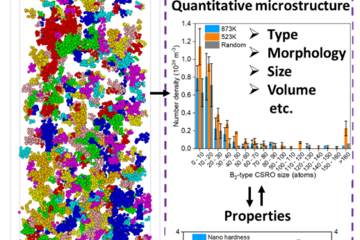All genres
1.
Journal Article
Faceting transition in aluminum as a grain boundary phase transition. Physical Review Materials 9 (8), 083607 (2025)
2.
Journal Article
High strain rate compressive deformation behavior of nickel microparticles. Materials Today 87, pp. 90 - 102 (2025)
3.
Journal Article
Topological grain boundary segregation transitions. Science 386 (6720), pp. 420 - 424 (2024)
4.
Journal Article
Grain boundary diffusion and segregation of Cr in Ni Σ11(1̄13)[110] bicrystals: Decoding the role of grain boundary defects. Acta Materialia 278, 120229 (2024)
5.
Journal Article
Influence of variation in grain boundary parameters on the evolution of atomic structure and properties of [111] tilt boundaries in aluminum. Acta Materialia 268, 119732 (2024)
6.
Journal Article
Stable nanofacets in [111] tilt grain boundaries of face-centered cubic metals. Physical Review Materials 8 (6), 063606 (2024)
7.
Journal Article
Effect of the atomic structure of complexions on the active disconnection mode during shear-coupled grain boundary motion. Physical Review Materials 8 (6), 063602 (2024)
8.
Journal Article
Breakdown of Reye’s theory in nanoscale wear. Journal of the Mechanics and Physics of Solids 173, 105236 (2023)
9.
Journal Article
Atomic-resolution observations of silver segregation in a [111] tilt grain boundary in copper. Physical Review B 107 (13), 134112 (2023)
10.
Journal Article
Universality of grain boundary phases in fcc metals: Case study on high-angle [111] symmetric tilt grain boundaries. Physical Review B 107 (5), 054103 (2023)
11.
Journal Article
Microstates and defects of incoherent Σ3 [111] twin boundaries in aluminum. Acta Materialia 243, 118499 (2023)
12.
Journal Article
Dual phase patterning during a congruent grain boundary phase transition in elemental copper. Nature Communications 13 (1), 3331 (2022)
13.
Journal Article
Understanding Grain Boundary Electrical Resistivity in Cu: The Effect of Boundary Structure. ACS Nano 15 (10), pp. 16607 - 16615 (2021)
14.
Journal Article
A Simple Mechanistic Model for Friction of Rough Partially Lubricated Surfaces. Tribology Letters 69 (3), 93 (2021)
15.
Talk
Compression of dewetted Nickel microparticles at ultra-high strain rates. 19th European Mechanics of Materials Conference, Madrid, Spain (2024)
16.
Talk
Influence of the Structure and Chemistry of Σ5 Grain Boundaries on Microscale Strengthening in Cu Bicrystals. TMS Annual Meeting and Exhibition 2024, Orlando, FL, USA (2024)
17.
Talk
Defect phases and their line defects in fcc metal grain boundaries. DPG-Frühjahrstagung 2024, Berlin, Germany (2024)
18.
Talk
Universality of grain boundary phases in [111] tilt boundaries of fcc metals. TMS 2024 Annual Meeting & Exhibition, Orlando, FL, USA (2024)
19.
Talk
Resolving grain boundary complexions in Copper by STEM and analyzing their impact on properties. Workshop Advanced Electron Microscopy in Materials Research, La Clusaz, France (2023)
20.
Talk
Atomistic Modeling of the Thermodynamics of Grain Boundaries in fcc Metals. 19th International Conference on Diffusion in Solids and Liquids, Crete, Greece (2023)











